On 13 July US Secretary of State Mike Pompeo made a policy statement on the South China Sea that if implemented will increase the possibility of a clash there. Although most of the content was not new, it was more detailed and more confrontational. Pompeo declared that China’s interference with Southeast Asian countries’ fishing or oil exploration and exploitation in their legitimate maritime zones-- and its own such activities in their zones are “unlawful” and “bullying”. He assured that “America stands with our Southeast Asian allies and partners in protecting their sovereign rights to offshore resources. He vowed that “We will support countries - - who recognize that China has violated their legal territorial claims and maritime claims as well ... We will provide them the assistance we can, whether that’s in multilateral bodies, whether that’s in ASEAN, whether that’s through legal responses. We will use all the tools we can ...” That presumably includes threat of use of force if necessary. To China these words were hostile and threatening. Contrary to the oft expressed plea for peace and stability by Southeast Asian states, this statement has generated instability and increased tensions.
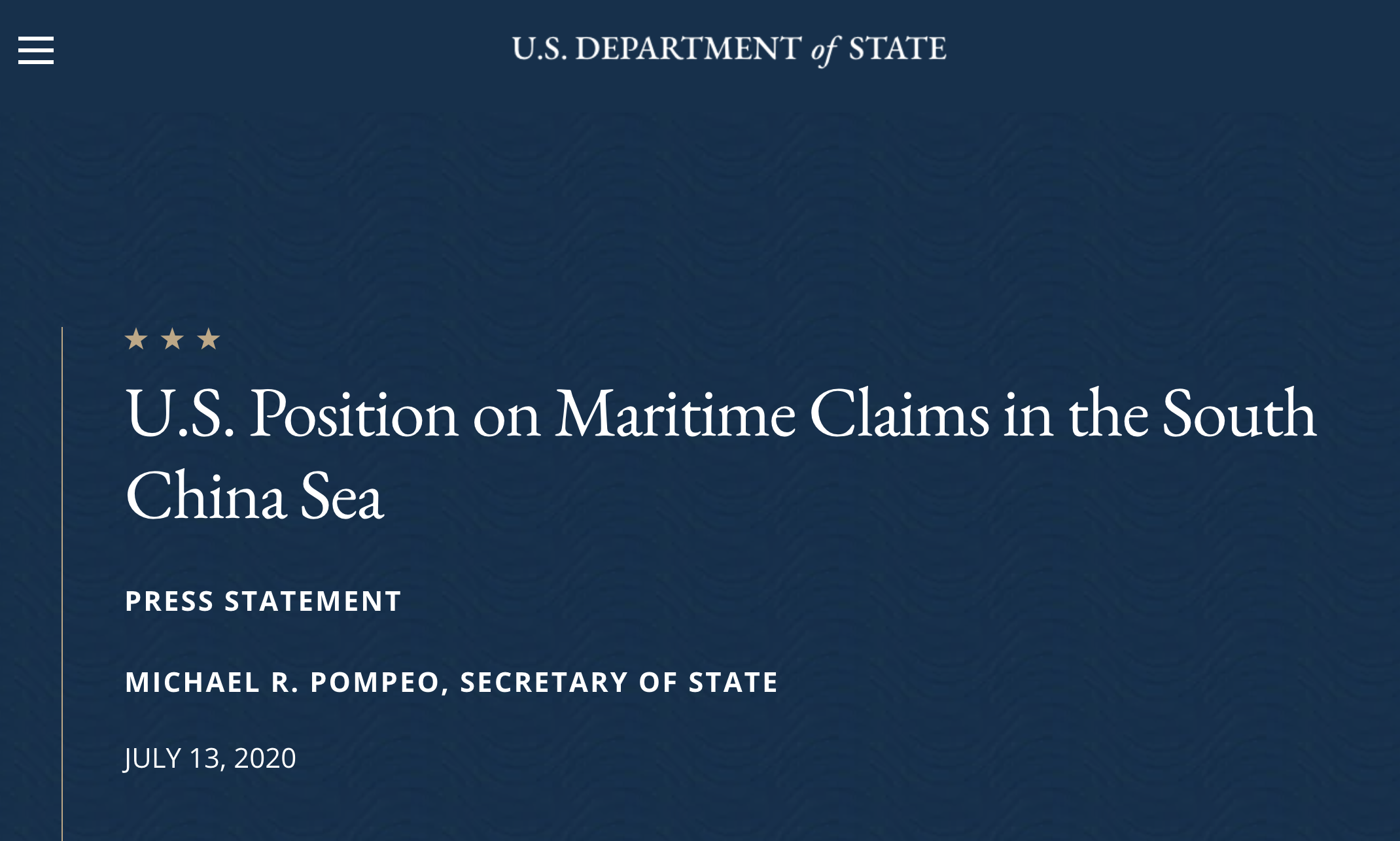
The aftermath of this declaration has witnessed a rash of tit-for-tat belligerent rhetoric and military posturing.
The U.S. followed up Pompeo’s policy ‘clarification’, with an across the board full court press of public relations, diplomacy and muscle flexing targeting China. The day after Pompeo’s statement, David Stilwell, the Assistant Secretary of State for East Asia, gave a follow up speech to the Center for Strategic and International Studies elaborating it. It was heavy with hubris, hyperbole and hypocrisy and further ratcheted up already taught tensions with China. Its thrust was to paint China as the lone villain in destabilizing the situation in the South China Sea. In a related development, the U.S. failed in its very public effort to prevent China from appointing another judge to the International Tribunal for the Law of the Sea because of China’s claims and actions in the South China Sea.
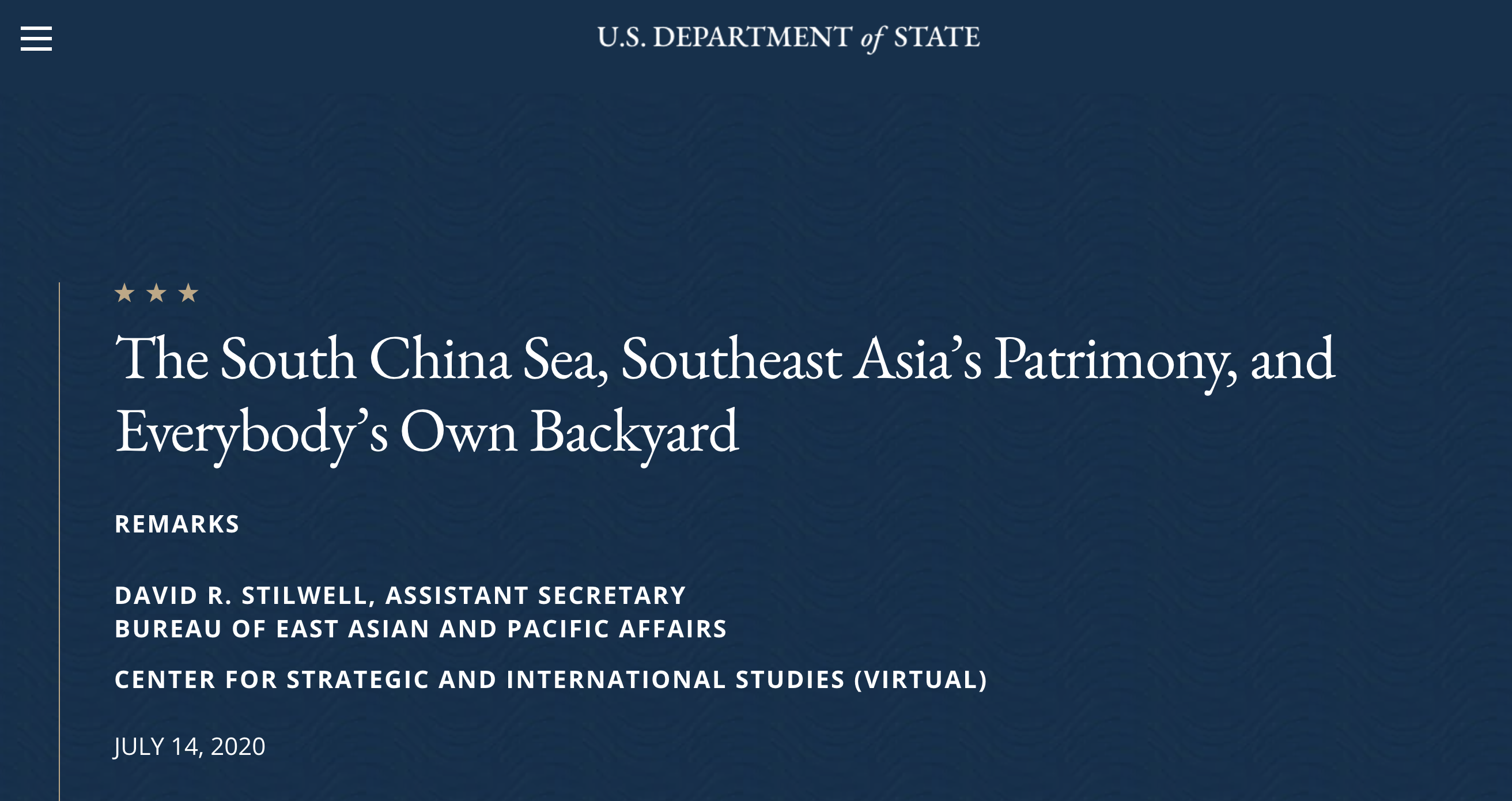
The U.S. navy undertook an unusual display of power by sending for the first time in nearly a decade two aircraft carrier strike groups to the South China Sea. On 25 August, China fired vaunted “aircraft-carrier killer” missiles into the South China Sea. One informed anonymous Chinese source said “This is China’s response to the potential risks brought by the increasingly frequent incoming US warplanes and military vessels in the South China Sea.”
These missile tests came on the heels of a US U-2 spy plane over flight of Chinese naval exercises in the Bohai Sea in violation of a “no fly zone”. China’s Defense Ministry said the over flight “seriously violated the code of conduct for the safety of air and maritime encounters between China and the U.S. - - and could have easily caused “misunderstanding and misjudgment and … an accident.” The U.S. followed up China’s missile test by deploying a another spy plane to monitor China’s military drills in the South China Sea hoping that China would fire another such missile whose capabilities and vulnerabilities could then be determined.

After the first exercise of two US aircraft carrier strike groups in the South China Sea, China stepped up its war games. In an unusual and significant move it conducted large drills in four different seas-- some simultaneously. Subsequently, the U.S. sent the Ronald Reagan strike group back to the South China Sea saying that this was “in response to China’s growing military assertiveness in the region.” Seemingly in response to that move, China held live-fire drills there a day later. One of the destroyers assigned to the Reagan strike group, the USS Mustin transited the Taiwan Strait provocatively crossing over the median line between China and Taiwan while Chinese warships monitored the passage. It then executed a presumably previously planned Freedom of Navigation Operation (FONOP) challenging China’s closing baselines around the Paracels and its regime requiring prior permission to enter its claimed territorial sea. Another US guided missile destroyer then transited the Taiwan Strait.
The U.S. alleges China is trying to coerce and entice its rival claimants into entering joint development agreements with its national oil company while discouraging these countries from involving outside oil companies including US companies. In what seemed like a harbinger of Pompeo’s policy declaration, the guided missile cruiser Bunker Hill, the guided missile destroyer Barry and the amphibious assault ship USS America ‘exercised’ with an Australian frigate near the site of an ongoing dispute between China, Vietnam and Malaysia over oil exploration rights. Two Chinese navy destroyers and a frigate soon arrived making the situation more dangerous and beyond the control of Vietnam or Malaysia. Other US warships also showed up. The U.S. Navy said that their presence “was necessary to support transparency, the rule of law, freedom of navigation and oversight.” According to Rear Admiral Fred Kacher, the Commander of Expeditionary Strike Group 7, “[These] operations [supporting Malaysia’s drill ship] West Capella demonstrate the depth of capability the US Navy has available in the region. There is no better signal of our support for a free and open Indo-Pacific…”. The West Capella and then the warships from both sides soon departed. Critics say that this was typical U.S. -- “showing up with the cavalry, just long enough to make things worse.” In any case the maneuver did not deter China from continuing to survey elsewhere in Malaysia’s claimed waters.
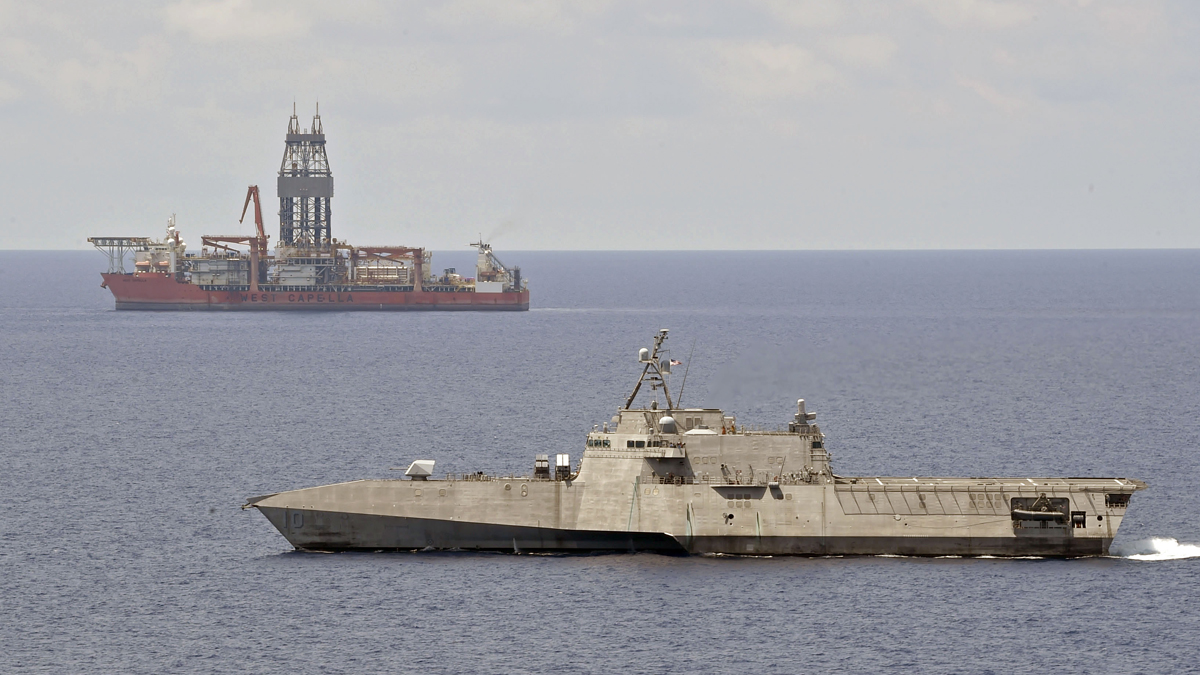
USS Giffords sailed near drillship West Capella, May 13
Another such ‘test’ may be in the offing. Malaysia’s National Oil Company Petronas is preparing to drill in an area off Sarawak that is within Malaysia’s claimed continental shelf but also within China’s nine-dash historic line claim. China may try to harass the drilling. If it does and if Malaysia asks for US military support will it provide it? Another possible test would be if Vietnam asks the U.S. for help in enforcing its new law prohibiting unlicensed foreign exploration and extraction of petroleum in its Exclusive Economic Zone.
The current US approach seems to be to “meet China’s greater assertiveness with a more assertive use of force of its own.” According to Esper, the U.S. is aggressively building “the capabilities that we need to deter China from committing to a major confrontation.” He affirmed the US intention to further step up its naval and air presence in the South China Sea and poured petrol on the fire by declaring “Goodwill and best wishes do not secure freedom. Strength does.” He outlined an across-the-board reorientation of the Department of Defense with the goal of countering China’s influence in Asia.
But Esper acknowledged that the U.S. can not dissuade China on its own. He said that strengthening [military] partnerships with Southeast Asian nations will provide the U.S. with an “asymmetric advantage” over China. He repeated and expanded upon these sentiments in an op-ed in the Wall Street Journal writing that US initiatives “reflect America’s steadfast commitment to stand with our allies and partners against Beijing’s bullying, support and defend the free and open international system… Yet the U.S. can’t shoulder this burden alone. We encourage like-minded nations to show solidarity and be more deliberate in aligning their policies on China in defense of our shared goals and interests.” He then vowed not to “cede an inch” mimicking China’s oft used phrase regarding its claims in the South China Sea.
As tensions rose, China’s pundits fired back. Hu Xijin, editor in chief of Global Times warned that “the US should be reminded to distance itself from China’s core interests. Don’t play with fire off China’s coast, don’t really stir up conflict over Taiwan question, and don’t overdo it in the South China Sea. If he [President Trump] thinks tensions will help his re-election campaign, and is not really ready for a military showdown, then be careful for the next few months, and don’t go too far.”
But avoiding conflict may not now be entirely up to the U.S.. Some think that some of China’s rival claimants will take advantage of such promised US backing to stand up to China. Indeed, some have publicly expressed their support of both the arbitration decision and UNCLOS in references to the South China Sea dispute. In another about face, erstwhile US ally the Philippines said “We need the US presence in Asia” to provide a balance of power. But that support only goes just so far. When the U.S. imposed sanctions on Chinese companies involved in the ‘militarization’ of its occupied features, the Philippines declined to follow suit declaring that “We are not a vassal state of any foreign power and we will pursue our national interest”.
Australia backed Pompeo’s statement by sending a letter to the United Nations rejecting China’s claims in the South China Sea that do not comport with the UN Convention on the Law of the Sea. Japan agreed to oppose countries that try to change the status quo by use of force. In a move that must have appeared as challenge to China, India supposedly deployed a warship to the South China Sea, although the details of what and where are unknown.
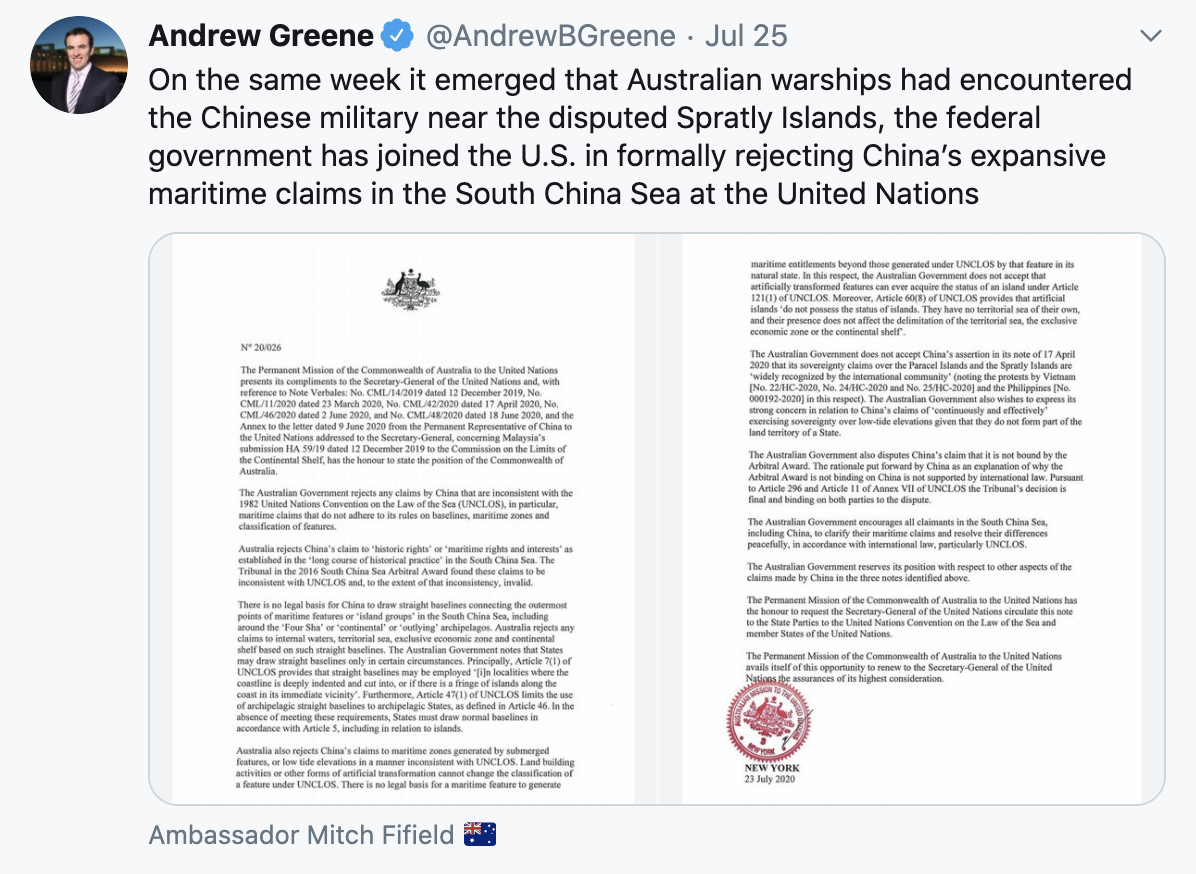
This all may be too little too late but it does give the U.S. moral support and a political excuse to press on with its agenda for the South China Sea.
The principal target of Pompeo’s policy ’clarification’ was not China but ASEAN and China’s rival claimants within it --Brunei, Malaysia, the Philippines and Vietnam. However, they failed to respond as he had hoped.
The ASEAN Foreign Ministers issued a statement on ASEAN’s 53rd anniversary reaffirming their intent to maintain Southeast Asia as "a region of peace, security, neutrality and stability" amid "growing uncertainties resulting from the changing geopolitical dynamics in the regional and global landscape."
The responses of most ASEAN members ranged from neutral to negative. Indonesia and Singapore were ‘neutral’ on this issue. A statement by Singapore’s Ministry of Foreign Affairs said “Singapore is not a claimant state and we do not take sides on the competing territorial claims”. “Our key interest is in maintaining peace and stability in one of the world’s busiest waterways.” Indonesia said that any country’s support for Indonesian rights in the Natuna Sea is “normal”. Malaysia was more direct. Its Foreign Minister Hishammuddin Hussein called for the big powers “to avoid military posturing”. He said Malaysia must avoid being “dragged and trapped” in a political tug of war between superpowers. He also expressed serious concern that the US-China struggle would split ASEAN. Even Vietnam, China’s leading regional critic avoided language that specifically ’called out’ China.
Philippines President Rodrigo Duterte publicly stated that the Philippines will form policies regarding China that are in their best interests—not necessarily those of others including those of the U.S..
It is not clear that China’s rival claimants would welcome or join in US military intervention. There are good reasons why a US-instigated anti-China front within ASEAN is unlikely to materialize. These nations all want China’s continued economic largesse and each have their own political/military reasons for not wanting to fall out of China’s favor. Moreover, they have some doubt as to whether the U.S. commitment will continue past the Presidential election and even if it does, they fear the consequences of a US-China conflict for them.
China also reached out to Southeast Asian countries seeking their support in its struggle with the U.S.. It asked them to resolve the disputes through dialogue and requested that they not side with the U.S.. China’s Foreign Minister Wang Yi was thought to have hinted that China might be prepared to be more conciliatory on the South China Sea issues. Bringing the struggle for hearts and mind into the open, he asserted “ASEAN countries cannot become the cat’s paws of the United States and cannot become victims of the strategic confrontation between China and the U.S..”
Where does it go from here? Many US analysts predict that the statement “paves the way for the U.S. to take stronger actions to challenge China’s assertive moves in the sea…” Some think the U.S. will engage in a more forceful diplomatic response to China’s actions in other’s EEZs including criticizing China in international forums like the UN, G7, G20, ASEAN Regional Forum, and East Asia Forum and imposing more targeted economic sanctions. It may even use threat of force to back up the smaller states.
Despite the risks, the U.S. continues to ratchet up the pressure—and tension. On 26 August, the Trump administration announced sanctions on companies that allegedly contributed to China’s construction and ‘militarization’ of the South China Sea. It apparently hoped that Southeast Asian countries would follow suit although the ban may hurt them economically.
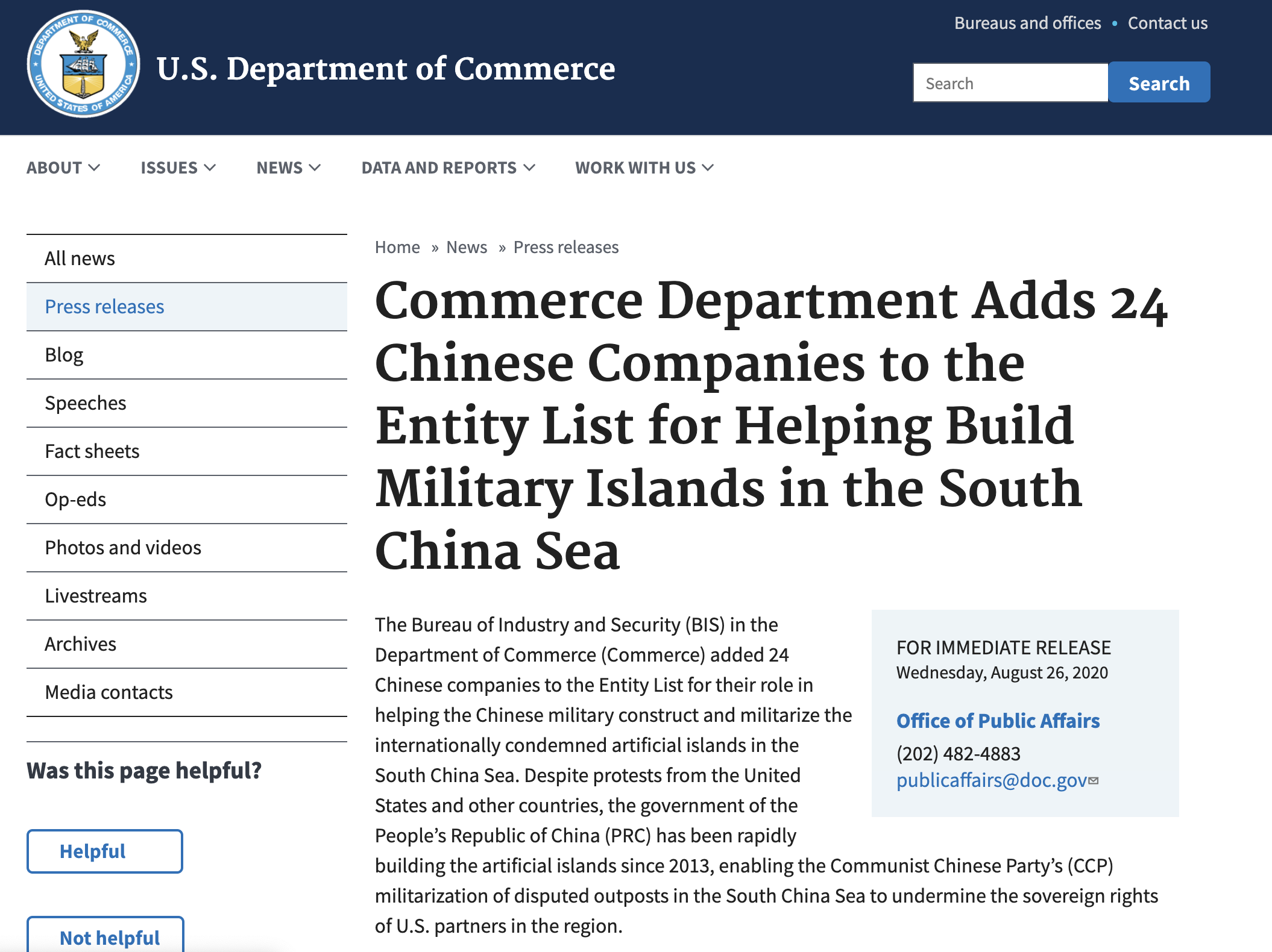
China responded by pointing out that it considers construction on its own territory a sovereign right. Some saw the US move as more evidence that the U.S. has taken sides in the disputes because it is ignoring the fact that China’s rival claimants have also engaged in construction and ‘militarization’ on their occupied features.
Implementing the details of Pompeo’s policy pronouncement will not contribute to peace and stability in the South China Sea—especially if it means the use of force. However, the good news is that the pronouncement may have been a domestically motivated last gasp of a dying and discredited administration. Its continuity –let alone follow-up—are in serious doubt. Hopefully China will not rise to the domestically-driven US bait.
The likely future is more of the same. The U.S. and China will likely continue their military posturing and step up their diplomatic contest for the hearts and minds of ASEAN states. The COC negotiations will drag on—in good part because of the continued behind the scenes US-China contest to control the content. The ASEAN members will lean more heavily on the UN Convention on the Law of the Sea and the 2016 arbitration decision against China to increase pressure on it to abide by the ruling—largely to no avail. They will also increase the tone and tenor of their opposition to outside military intervention regarding their disputes with China-- again with limited success.
In the longer term, if the U.S. wants to avoid direct conflict with China in the South China Sea -- or at least postpone it-- it must accommodate or at least appear to accommodate to some degree China’s international interests and aspirations there— On what issues, when, how, and how much are questions to ponder and negotiate.

